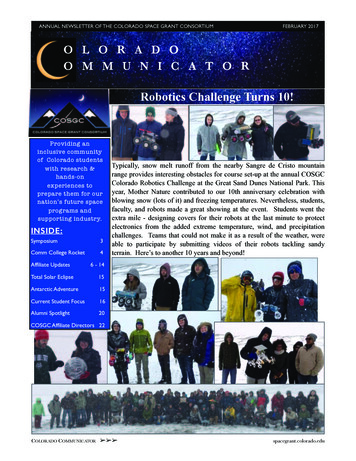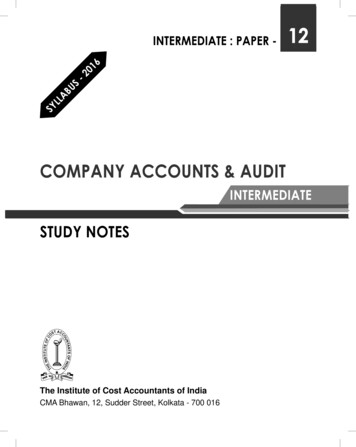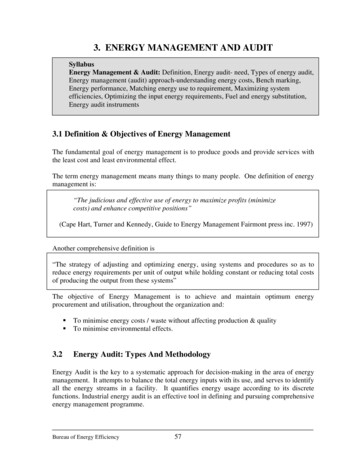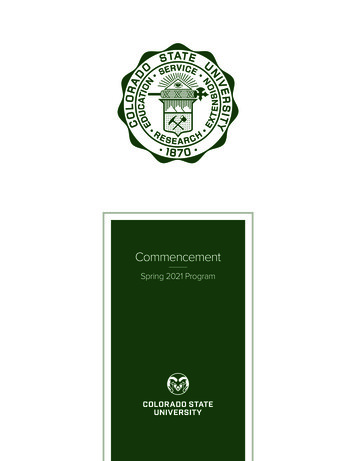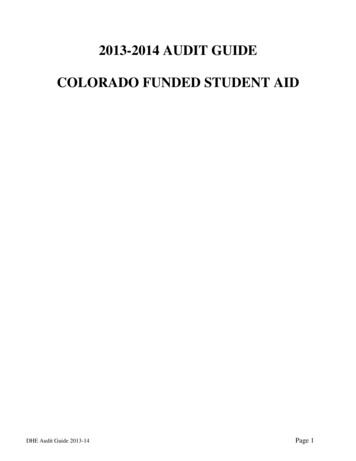
Transcription
2013-2014 AUDIT GUIDECOLORADO FUNDED STUDENT AIDDHE Audit Guide 2013-14Page 1
TABLE OF CONTENTSAUDIT GUIDE GENERAL INSTRUCTIONS .2DEFINITIONS .4COLORADO FINANCIAL AID .9THE INSTITUTION'S ABILITY TO HANDLE FUNDS IN ACCORDANCEWITH STANDARD ACCOUNTING PRACTICES .16AUDIT PROGRAM CHECK LIST .18AUDIT GUIDE GENERAL INSTRUCTIONSFinancial Aid FlexibilityDuring the 2010 legislative session, the passage of SB 10-003 created financial aid flexibility forpublic institutions and non-profit private institutions beginning in the 2012-2013 academic year.Institutions eligible for financial aid flexibility shall administer a financial assistance programaccording to policies and procedures established by the governing board of the institution thatalign with state statute (C.R.S. §23-3.3-102, (3)). Audits for such institutions should align withthe approved policies and procedures of each governing board.This audit guide is to be used for financial aid audits of institutions that are not eligible for thefinancial aid flexibility under state statute (C.R.S. §23-3.3-102, (3)). Institutions that arerequired to award state funded financial aid under DHE guidelines and policies are listed below:Art Institute of ColoradoEverest College (Blair)Everest College NorthColorado Technical UniversityConCorde Career InstituteDevry UniversityHeritage CollegeIntellitec College--CSIntellitec College--GJIntellitec Medical InstituteInternational Salon and Spa AcademyInstitute of Business and Medical CareersKaplan CollegeRocky Mountain College of Art & DesignRedstone (Westwood Aviation)Westwood CollegeDHE Audit Guide 2013-14Page 2
COLORADO STUDENT AIDCOLORADO-FUNDED STUDENT FINANCIAL AIDThis guide is to be used in conducting performance and financial audits at Coloradopostsecondary education institutions that are participating in one or more state-funded studentassistance programs. The audits will examine:1.2.3.4.5.The institution’s administrative performanceThe institution’s commitment to serving studentsThe institution’s compliance with state policy and guidelinesThe institution’s ability to handle funds in accordance with standard accounting practicesThe institution’s fiscal stabilityAudits are to be conducted every two years, unless a prior audit contains audit findings.Institutions with audit findings are subject to annual audit review to maintain financial aideligibility. The Department of Higher Education (DHE) will provide a letter that releases aninstitution from annual review.Institutional audits should include both federal and state financial assistance programs.Reports are due by April 1, 2013 for 2012-2013 calendar year.Reports are due by April 1, 2014 for 2013-2014 calendar year.Step 1: Prior to the audit visit, the auditors should collect:1.2.3.4.5.6.DHE’s Financial Aid Policy and Guidelines in effect for the fiscal year being cialAid/Educators.html)DHE’s Audit Guidelines for the year being audited (http://highered.colorado.gov/Finance/ FinancialAid/Educators.html)State budget parameters for cialAid/Policy/1314 stufabudgparms.pdf)The prior audit report, including the findings, and recommendationsAn institution’s plan and implementation schedule to address recommendations fromprior auditsA compliance sample drawn from the Student Unit Record Data System (SURDS)Financial Aid ReportStep 2: Complete the questionnaireStep 3: Conduct the auditStep 4: Sign the audit statementsStep 5: Send copies to the appropriate parties.Audits should be sent to the following addresses:DHE Audit Guide 2013-14Page 3
COLORADO STUDENT AIDColorado Department of Higher Education1560 BroadwaySuite 1600Denver, CO 80202Colorado Office of the State Auditor225 East 16th AvenueSuite 555Denver, CO 80203Questions about definitions or policy interpretation for the Colorado student aid programs shouldbe directed to:Julia Ramsey, Budget DirectorCelina Duran, Financial Aid AdministratorMark Cavanaugh, Chief Financial OfficerDEFINITIONS1."State-funded student assistance" includes funds provided under the following programs:A.Need-based Programs: B.Colorado Student Grant (CCRP) / Colorado Graduate Grant (CCG)Colorado Need-Based Work-StudyPerkins Student Loan MatchNon-need-based Programs: Colorado Work-Study (up to 30 percent of allocation)2."Colorado resident student" means a student who is eligible for in-state tuitionclassification as defined in Title 23, Article 7, C.R.S., for public institutions. Fornon-public institutions the tuition classification statute has been interpreted for financialaid purposes only; private institutions should be collecting information required on theCCHE Residency Classification Form (# CCHE-C-1) to determine residency.3."Self-supporting" or "independent student" means a student who meets the requirementsfor self-supporting or independent student status as defined in regulations and policygoverning the Federal campus-based financial aid programs (cit. Public Law 99-498Section 480).4."Dependent student" means a student who does not qualify as a self-supporting orindependent student under Section 2.03.5."Eligible institution" means an educational institution operating in Colorado that meetsthe requirements specified in C.R.S. 23-3.3-101, as verified through the "Application toParticipate in State-Funded Student Assistance Programs" submitted to the ColoradoDepartment of Higher Education. A change in ownership of an eligible proprietaryinstitution terminates eligibility and a new application must be submitted.6."Eligible program" means a program of education or training which:DHE Audit Guide 2013-14Page 4
COLORADO STUDENT AID7.8. Admits as regular students only persons having a certificate of graduation from asecondary school (high school graduates), the recognized equivalent of thatcertificate (GED), or persons beyond the age of compulsory school attendance inthe State of Colorado who have been shown to have the ability to benefit from theeducation or training offered. Leads to a bachelors, associate, professional, or higher degree, or Is at least a two-year program which is acceptable for full credit toward a bachelorsdegree, or Is at least a one-year program leading to a certificate or degree that prepares astudent for gainful employment in a recognized occupation, or Is, for a proprietary institution or a postsecondary vocational institution, a programof at least six months (16 semester or trimester hours, or 24 quarter hours, or 600clock hours) duration leading to a certificate or degree which prepares students forgainful employment in a recognized occupation."Undergraduate student" means a U.S. Citizen or permanent resident who is in attendanceat an institution of postsecondary education and is enrolled in an eligible program leadingto a postsecondary certificate, associate degree, or first baccalaureate degree. Students admitted as special students may be considered to be undergraduates forone term only if it is anticipated that the student will be enrolled in a regularundergraduate degree program in the following term. This definition includes students enrolled in basic skills courses designed to correctspot deficiencies concurrent with enrollment in courses that can be counted towardthe certificate or degree. Students enrolled solely in Adult Basic Education, General Education DevelopmentCourses (A.B.E./G.E.D.), or equivalent pre-college programs are not considered tobe undergraduates and are not eligible for any program of state-funded studentassistance. Students enrolled concurrently in A.B.E./G.E.D. courses and regularcollege level courses are undergraduates, but their enrollment status (full-time,half-time, less than half-time) is based only on their courses that bear creditattributable toward a postsecondary degree or certificate. Students concurrently enrolled in high school courses are not eligible for statefinancial aid assistance (e.g., post-secondary options, fast-track)"Special Attendance Categories" means undergraduate students may be considered to bein attendance at a “home institution,” when they are enrolled in study abroad, cashfunded courses, or consortium courses. The enrollment must meet all four followingtests:DHE Audit Guide 2013-14Page 5
COLORADO STUDENT AID The student is admitted and enrolled in a degree or certificate program at the homeinstitution; The credits earned in a special attendance category are applicable toward the programas if the credits were earned in regular courses at the home institution; The student's transcript at the home institution shows the individual classes taken; and When another institution offers the courses, agreements exist between the institutionsdescribing the acceptance of the courses toward the program to which the student isadmitted prior to that enrollment.9."Graduate student" means a student who is in attendance at an institution of highereducation and is enrolled in an academic program of instruction above the baccalaureatelevel. The term includes any portion of a program leading to either a degree beyond thebaccalaureate, or a first professional degree when at least three years of study at thepre-baccalaureate degree level are required for entrance into a program leading to such adegree. Students admitted as special/provisional graduate students may be considered aseligible students for one term only if it is anticipated they will enroll in a regular graduateprogram in the following term.10."Professional student" means a student who is in attendance at an institution of highereducation and is enrolled in veterinary medicine, law, dentistry, pharmacy (Pharm. D.only), and medicine (M.D. program only).11."Secondary student" means a student who is enrolled in high school or enrolled solely inAdult Basic Education (A.B.E.) or General Educational Development courses (G.E.D.).12."Full-time student" means an undergraduate student who is carrying 12 or more creditsper semester or a graduate student who is enrolled in 9 or more credits per semester.13."Half-time student" means a student who is carrying any combination of courses,research, or special studies that are attributable toward a postsecondary certificate ordegree, including remedial courses for students enrolled at community colleges or otherinstitutions with a two-year role and mission. For undergraduate students:- 6 semester or quarter hours per regular academic term; or- 12 clock hours per week; Or graduate students:- 4 semester or quarter hours per regular academic term.14."Less than half-time student" means a student who is not enrolled at least half-time asDHE Audit Guide 2013-14Page 6
COLORADO STUDENT AIDdefined in Section 2.13.15."Documented financial need" means the difference between the student's budget and thefamily's resources as evaluated by the formula known as "Federal Needs AnalysisMethodology" specified in federal law.16."Over-award" means the total resources awarded exceed financial need by 1.00 (onedollar) or more at the end of the academic year.17.“Tolerance” – the degree that a need based recipient’s award package may exceed theactual need; under the Colorado guidelines, there are two situations in which a student’saward may exceed the student’s need. A need-based recipient that receives an undergraduate merit scholarship mayexceed the total need if the over-award is less than 301. The scholarshiprecipient’s award package must be adjusted if the over-award exceeds 300. Colorado Work-Study Program permits a 300 tolerance.18."Over-payment" means any money disbursed to the student in excess of the award, or inexcess of need.19."Refund" means funds for tuition, fees, room, board, and/or other institutional fees thatare returned to the student by the institution, usually as a result of the student leavingschool.20."Repayment" refers to the process of returning those unearned financial aid fundsreceived by the institution or the student, for a specific academic period that are notattributable to educational costs incurred for that period. Consequently, these amountsmust be returned to the appropriate financial aid fund as determined by the Return toTitle IV calculation.21."Eligible Student" means an undergraduate, graduate, or professional student enrolled inan eligible postsecondary certificate or degree program who: Maintains satisfactory academic progress toward the degree or certificate, asdefined by an institution in accordance with state and federal guidelines. Does not owe a repayment, and is not in default on an educational grant or loan.22."Award year" means the fiscal year, July 1 through June 30, for which funds areallocated. Awards may be for one or more academic terms occurring within that fiscalyear period. Summer enrollment must begin before the close of the fiscal year or endwithin the fiscal year to be included.23."Documentation" means the practice of collecting information to support applications forneed-based financial aid.DHE Audit Guide 2013-14Page 7
COLORADO STUDENT AID24."Verification" means the process of comparing information obtained from diversesources and determining that the information is accurate and/or compatible.DHE Audit Guide 2013-14Page 8
COLORADO STUDENT AIDCOLORADO FINANCIAL AIDTHE INSTITUTION’S ADMINISTRATIVE PERFORMANCEPART 1FYE June 30,2013INSTITUTIONNAMEFYE June 30,2014NAMEGeneral AdministrationList name of the individual who has the responsibility for:A.Coordination of all student assistance at theinstitutionB.Development of institutional plans for the administration ofstudent assistance programsC.Sub-allocations of funds among department or programs forthe assistance program listed in (B) above, if the institution hasdecided to make such sub-allocationD.E.Selection of recipients and offering of awards for:1)Need-based, undergraduate student assistance program2)Each program listed in BPayment authorization for assistance awards:1)Need-based2)Merit program3)Work study programsF.Disbursement of awardsG.Maintenance of records for State-Funded programsH.Maintenance of accounting recordsI.Establishment of levels of expenditureDHE Audit Guide 2013-14Page 9
COLORADO STUDENT AIDII.Financial Aid CommitteeA.B.YESHas the institution established a financial aid committee toadvise the financial aid director regarding institutionpolicies for state-funded student aid?NO OTHERList members of committee:Has the institution1)2)III.Identified a procedure by which students can appealdecisions of the financial aid office?Disseminated that information to studentsStudent Consumer Information RequirementsA.Are students fully informed of the availability of allState-funded student aid programs?B.How are the students informed?C.Does information include, at the minimum:1)2)3)4)5)6)7)8)9)DHE Audit Guide 2013-14Names of the programs?The amount of assistance from each program?The eligibility requirements for each program?The criteria used to elect recipients from the groupof eligible applicants?The application process for each program?The packaging policy of the institution?What the student must do to retain eligibility,including "Standards of Satisfactory AcademicProgress for Financial Aid” (Section 3.02)?What penalties may be imposed for fraud or abuse?Procedures for appeal of disputed decisions?Page 10
COLORADO STUDENT AIDPART 2IV.THE INSTITUTION’S COMMITMENT TO SERVING STUDENTSNotice of StatusA.Are students who submit applications for state-fundedstudent assistance notified of the status of their application?B.Is notification given on all need based award offers?C.Are notifications of awards provided in:Are all application forms and award status noticesmaintained in the financial aid office?1)2)3)4)5)D.V.YES NO OTHERWritten form?Electronic formVerbal?Other?For verbal notification, is conversation documented bynote to file with date, time, and message?Satisfactory ProgressA.B.Has the institution established "Standards of SatisfactoryAcademic Progress" which must be met if students are tocontinue to receive State-funded student assistance?Do the standards address both:1)2)C.Good standing?Academic progress?Do the standards provide for:1)2)DHE Audit Guide 2013-14The grade point for need-based programs (or academicstatus if grade point is not calculated for the program)which must be achieved each term and/or thecumulative grade point for undergraduates (oracademic status) which must be maintained tocontinue to be eligible for state-funded studentassistance?The cumulative grade point (3.5 or above) for meritprograms that must be achieved to continue to beeligible for state merit grants except as allowed in theguidelines?Page 11
COLORADO STUDENT AIDYESNO OTHERHas the institution established internal procedures to provideprompt notification to the financial aid office whenever astudent withdraws? Do the procedures:3)4)5)6)VI.The number or percentage of hours attributable towarda degree or certificate which must be completed eachterm or academic year to continue to be eligible forstate-funded student assistance, and the maximumnumber of hours or terms that may be supported bystate or federally funded student aid at each degreelevel?The penalties for failure to achieve the abovestandards, including whether or not a probationaryperiod is allowed, the process for removal of thepenalty and reinstatement to full eligibility, and theprocess to appeal any penalty or decision concerningcontinuation of aid?The procedures and timetable used to monitor eachrecipient's academic standing and progress?The policies and procedures for monitoring repeatedcourses, remedial courses, and the treatment of theincremental measurement requirement?Withdrawal ProceduresA.1)2)3)DHE Audit Guide 2013-14Ensure that refunds of tuition or institutional room andboard charges paid from student aid funds are returnedto those funds, not to the student, according toinstitutional policies developed in response to Section3.03?Provide an opportunity for required exit interviews?Provide an opportunity to discuss the implications ofthe satisfactory progress policy and procedures forreapplying for aid at a later date?Page 12
COLORADO STUDENT AIDPART 3 TEPolicies for Need-Based FundsA.B.C.D.ANDNO OTHERDo the application policies require use of the U.S.Department of Education Free Application for FederalStudent Aid (FAFSA)?To be considered for aid, do independent students submitdocumentation to their school's financial aid office inaccordance with federal requirements?Are all discrepancies between the FAFSA and the incometax return resolved?Has the financial aid office obtained information regardingstudents certified for:1)2)E.YESPOLICYa. veterans benefits if required? (Note: Effective withthe 2011-12 award year, veteran educational benefitsno longer treated as estimated financial assistance)b. other public benefits?Are benefits compared with the financial aidapplication and apparent discrepancies resolved?Is it institutional policy that no State-funded, need-basedstudent assistance is disbursed until a complete applicationis submitted containing:1)2)3)4)5)6)DHE Audit Guide 2013-14All required application signatures?Required certification by student that (he/she) does notowe a repayment to any institution and is not indefault on any educational loan to any institution?Application has sufficient information to determineeligibility?Sufficient information and detail on application toevaluate need using a valid FAFSA?Application contains statements of penalties forintentionally providing incorrect information?Information is collected that parallels the informationrequired by CCHE in its Residency ClassificationForm (CCHE-C-1)?For private schools, thisinformation is used for state-funded financial aidpurposes only.Page 13
COLORADO STUDENT AIDF.G.Is the institutional student budget constructed usingparameters recommended by CCHE to include costsdescribed in I, J, K below? If not, was justification sent toCCHE? Was approval granted?Full-time enrollment?Half-time enrollment?NOTE: Less than half-time enrollment is nolonger eligible for state aid.Full-time enrollment?Half-time enrollment?Less than half-time enrollment?Does the budget provide the cost of living for student andinclude the following expenses:1)2)3)4)5)6)7)8.)9.10.11.J.Does the budget include books and supplies and recognizedifference in costs for:1)2)I.NO OTHERDoes the budget include the current year's tuition and fees,recognizing difference in charges g, personal maintenance, recreationentertainment?Medical care?Dependent care?Loan fees for student borrower?Disability expenses (if applicable)Study abroad expenses (if applicable)First professional license (if applicable)Coop education expenses (if applicable)andRequired packaging policy elements:1)2)DHE Audit Guide 2013-14Are offers of financial aid always equal to or less thandocumented need?Does the institution have procedures to give highestpriority to the neediest Colorado residents as requiredby the Colorado College Responsibility Program?NOTE: The audit team must make a statementregarding this packaging element, explicitly statinghow the institution implements its priority.Page 14
COLORADO STUDENT AIDK.Does the institution's written packaging policy address the YES NO OTHERfollowing elements:1)2)3)Use a published financial aid application deadline orprocess applications on a rolling award basis?The method by which aid is awarded to less thanfull-time students?The methodology for making need-based awards: award some aid to all eligible applicants?award some aid to all the neediest students (e.g.,EFC 0), but provides aid to other lower-needstudents if funds are available? attempts to meet full need of the neediest students?NOTE:The audit team must include astatement in the compliance report, explicitlydescribing the institution’s packaging priorityfor need-based applicantsDHE Audit Guide 2013-14Page 15
COLORADO STUDENT AIDPART 4:XIII.THE INSTITUTION’S ABILITY TO HANDLE FUNDS IN ACCORDANCEWITH STANDARD ACCOUNTING PRACTICESFraud and AbuseM.Has the institution taken reasonable measures toprevent fraud and abuse in State-funded aid programs byat least requiring:YESNO OTHER1)2)3)4)5)6)N.Collection of supporting documentation?Reconciliation of apparent discrepancies ininformation submitted in support of an applicationfor State-funded student aid?Establishment of due process procedures for studentssuspected of fraud and penalties for proven fraud?a. procedures established to notify student of theprocess and penalties?Separation of award authorization and disbursementfunctions?Whether priority is given to students based onwhether they are entering or continuing studentsor their year in school?Within the institution’s packaging policy, is thephilosophy by which grant, work, and loan arecombined in packages of assistance and the maximumtotal package any one student may receive, recognizingthat different policies may exist for different categoriesof students (e.g., , lower-division vs. upper-division)?Do all award notices for state-funded student assistancecontain:1)The period for which aid is granted?2)The awards offered, including the full name of theaward?3)Award conditions including: 4)DHE Audit Guide 2013-14compliance with the Standards of SatisfactoryAcademic Progress policy?conditions specific to a particular program,including agreement to repay any loan?A mechanism by which the student can rejecteach component of the aid package?Page 16
COLORADO STUDENT AID5)P.Period of enrollment?Level of enrollment (e.g., full-time)?Costs?Resources (Whenever student is over-awarded)?Does the institution fully document in the individualrecord any action taken to amend or suspend anaward after initial offer and acceptance?1)R.NOOTHERDoes the institution revise awards in response to change ina student’s:1)2)3)4)Q.A statement that the student has read, understands,and agrees to the award conditions?YESDoes the file clearly specify the reason for change?Does the institution have procedures to insure that studentscannot receive more than:1)2)DHE Audit Guide 2013-14 5,000 per year from CSG? 5,000 per year from Graduate Grant?Page 17
AUDIT PROGRAMCHECK LISTPART 1STATE-FUNDED STUDENT ASSISTANCE s Audit Program includes:I.Audit ObjectivesThe objectives of this audit are to determine whether:A. The institution has established procedures for coordinating assistanceprovided under all state student aid programs in which itparticipates.B. The institution has established systems of internal control, accounting,and reporting, and has exercised proper controls in the operation ofand accounting for the funds provided for the programs.C. The institution has established and has followed policies and proceduresto ensure that the funds provided are being used only for thepurposes set forth in the CCHE’s Financial Aid Policy andGuidelines for State-Funded Student Assistance Programs.D. The institution has established a control and self-evaluation systemintended to monitor and evaluate the programs to determine if itsobjectives are met.II.Audit StepsA. Internal ControlsReview the system of internal controls applicable to the StatePrograms of Financial Aid to determine whether the policies andprocedures established by the institution are written, and provide forappropriate segregation of responsibilities and controls that arereasonable in the circumstances over:DHE Audit Guide 2013-14Page 18
FYEJune30,20131)2)3)4)FYEJune30,2014The determination of awardsThe receipt and disbursement of fundsThe recording of transactionsThe reporting process to DHEResults of the review of the system of internal controls should beconsidered by the auditor in determining the extent of testing neededto provide the adequate data for evaluating the effectiveness of theestablished procedures.B. Examination of AccountsObtain a trial balance as of June 30 of the accounts maintained bythe institution for its programs. This should include a disbursementrun for all financial aid programs as reported on the Fiscal Report ofExpenditures submitted to DHE.1)2)3)4)5)DHE Audit Guide 2013-14Agree totals of disbursement run to institutions general ledger.Check arithmetical accuracy.Agree total of disbursements run to amounts transferred fromDHE or satisfactorily reconcile same.Select, either from the Student Unit Record Data System(SURDS) financial aid report or the listing of aid recipients, arepresentative number of students receiving awards from eachprogram per disbursement run.Review documentationcontained in student's financial aid record. Verify eligibility bydetermining compliance with existing guidelines and/orstatutory provision for each program that follows.Agree grant expenditures as stated on student award letters arerecorded in the student accountsAgree totals of state financial aid programs reported on FiscalReport of Expenditure with fund totals contained on theSURDS report.Page 19
FYEJune30,2013III.FYEJune30,2014Financial Compliance ProgramsA. Colorado Student Grant Program1)Colorado Need-based ProgramThe purpose of the Colorado Need-Based program is to assiststudents who cannot otherwise afford to attend college. TheColorado Student Grant and Colorado Graduate Grantprograms are designed for students with demonstratedfinancial need.The Colorado Student Grant program is the name given to theundergraduate need-based program funded by annual stateappropriations.The Colorado Graduate Grant Program refers to the need-basedgraduate grant program.2) Student EligibilityIn order to receive a Need-Based Grant, students must submit aFAFSA application and meet the following eligibility criteria3) Colorado resident, as determined by the institution's tuitionclassification officer in accordance with applicable State law4) Undergraduate student or graduate student5) In good standing and demonstrate academic progress accordingto the institution's policy regarding Standards of AcademicProgress for financial aid purposes6) Show financial need according to the Federal Needs AnalysisMethodology3) Limitations on AwardsStudents Enrolled on Full-time or Half-time BasisDegree seeking undergraduate students who are enrolled eitherfull-time or at least half-time may be awarded Colorado needbased grants up to but not in excess of 5,000 in any fiscal yearor the level of need remaining after all resources, includingDHE Audit Guide 2013-14Page 20
other sources of financial aid, have been taken into account,whichever amount is less. Need-based grants shall not exceedthe documented financial need of the student.Graduate students must be enrolled in an approved STEM , be a Colorado resident and be enrolled at leasthalftime (i.e., four credit hours per term). Additionally,graduate students must also show documented financial need.To ensure that state need-based dollars are directed to eligibleColorado resident students who have the least ability to pay fortheir education; CCHE policy defines three funding levels.Using Expected Family Contribution, the institution will awardneed-based dollars to Level 1 applicants. Level 2 applicantswill be considered after meeting the need of Level 1 applicants.Reasonable administrative practices, such as applicationdeadlines, are recognized as realistic and appropriate. Level 1:Students with the least ability to payStudents with an
This audit guide is to be used for financial aid audits of institutions that are not eligible for the financial aid flexibility under state statute (C.R.S. §23-3.3-102, (3)). Institutions that are required to award state funded financial aid under DHE guidelines and policies are listed below: Art Institute of Colorado Everest College (Blair)




